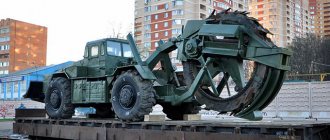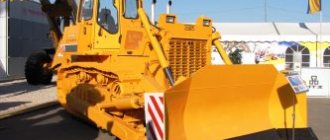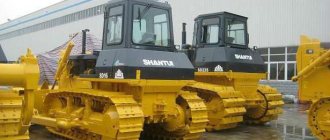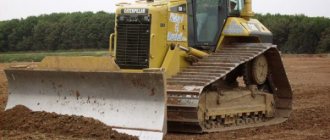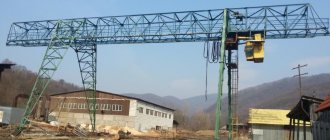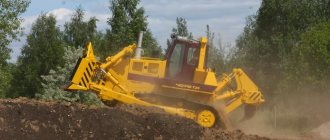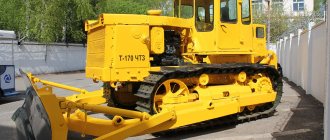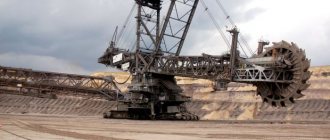A bulldozer is an earth-moving machine capable of moving independently and efficiently excavating soil or other rocks. The equipment has a simple configuration. The main part is a tractor or tractor, combining a powerful chassis and a cabin with controls. The working unit of the bulldozer is represented by a curved profile blade located outside the main structure. High productivity, the ability to move large volumes of rock and the ability to perform various types of tasks have ensured the demand for this equipment in many areas.
Areas of use
Today, bulldozers are actively used in road construction, construction, mining and other enterprises. The ability of equipment to cut, dig and move soil, rocks and other bulk materials is also used to mechanize such types of work as:
- leveling of territories and cleaning of gentle slopes;
- removal of fertile soil during construction site preparation;
- creation of shallow channels;
- arrangement of embankments;
- cleaning the bases for the foundations of structures;
- development of soil on slopes;
- filling trenches and other depressions;
- clearing the mining area;
- clearing large areas of debris, stones, snow, etc.
Specifications
The parameters of a bulldozer tractor may vary. It depends on what model the equipment is and what it is intended for. The general view is represented by the following characteristics:
- the bulldozer weighs up to 106 tons;
- engine power is up to 600 kW;
- moves rocks over a distance of 200 meters;
- has a height of 2300 mm;
- the dump has a depth of 800 mm, a lift of 1780 mm, a width of up to 6100 mm, a height of up to 2200 mm, a length of up to 5500 mm, and a weight of up to 10 tons.
Types of bulldozers
By appointment. This criterion determines the possibility of using bulldozers for certain types of work. The technique is:
- general purpose – designed for earthmoving, planning and construction tasks;
- specialized - such bulldozers are used in underground or underwater mining.
According to the type of climate control. This feature indicates the ability to operate machines in certain climatic zones. Bulldozers may have a non-standard design:
- with adaptation for work in low temperature conditions (up to -50 degrees);
- with adaptation to the tropical climate (temperatures up to +45 degrees and increased precipitation).
On the chassis. The type of chassis determines the ability to move equipment on different types of surfaces. A modern bulldozer may have the following movable base:
- tracked – effective for use in off-road conditions;
- wheeled – Suitable for frequent travel on public roads.
By dump type. The shield, the main working part of a bulldozer, can have different designs and mobility. Depending on the model, the equipment is equipped with the following types of dumps:
- non-rotating – installed perpendicularly and moves up/down;
- rotary – mounted at an angle in a horizontal or vertical plane;
- universal - consists of two halves, makes turns in different directions.
According to the lifting drive mechanism. This feature determines the maneuverability of the working body of the bulldozer (turning, lowering, skewing, tilting). The lifting mechanism can be:
- hydraulic – consists of hydraulic cylinders;
- electromechanical – has a combined configuration;
- mechanical - includes a winch and a system of rope blocks.
From a “mechanical shovel” to a high-tech unit
By the way, the word “bulldozer”, which appeared in everyday use at the same time, did not characterize any specific mechanism, but the force that had to be applied in order to move any mass. The first progenitor of this unit, referred to only as a “mechanical shovel,” looked very impressive, was clumsy, noisy and had only 15-30 hp. With. power. But still, in the middle of the 19th century it was a certain success. And after just a short period of time, the power units of these machines acquired the necessary power to carry out the entire range of work.
Go to the bulldozer catalog
A modern, familiar bulldozer is a complex engineering machine or a separate attachment that operates in a cyclic manner. The main working unit of a bulldozer is the blade. A separate drive of the working part (hydraulic or mechanical) is capable of raising, turning, tilting and lowering the blade. Thanks to this, the cost of such high-power equipment when moving soil is minimized. After all, engine power is not wasted on this. A modern bulldozer is a self-propelled machine, most often built on a tractor chassis (tracked or wheeled) and equipped with a blade of various designs. However, both a self-propelled excavator and a pipe layer can have a bulldozer blade, which greatly increases their performance and versatility.
Cat® Bulldozers
- Cat D6R2
Crawler bulldozerEngine Model Cat C9 ACERT™ Net Power 141 kW Operating Weight 18,984 - 21,613 kg
Price request
Crawler bulldozer
Engine Model Cat® 3406C DITA Net Power 239 kW Operating Weight 37,557 kg
- Price request
Other models
The American brand Caterpillar is one of the world leaders in the production of powerful and efficient special equipment. The rental and sale of bulldozers of this brand are in great demand: the machines are actively used in different climatic and working conditions. The Cat® brand includes a variety of crawler models. Among the presented machines, you can choose a bulldozer of small, medium and high power with the optimal blade size and productivity. If necessary, the equipment can be equipped with replacement equipment (rippers, extenders, openings, slopes). Learn more about the range and features of Cat® bulldozers here.
Cat® D3K2
The Cat® D3K2 Crawler Dozer is designed for a variety of earthmoving applications. It can carry out layer-by-layer digging and moving soil, mining, territory planning when arranging green areas, etc.
The D3K2 model has advanced capabilities. A set of new functions includes slope indication, automatic blade setting when working on slopes, traction control and a number of others. The dozer is equipped with the AccuGrade™ system, which allows the operator to cut and fill soil with high accuracy without additional site measurements.
The Cat® C4.4 ACERT diesel engine meets Tier 3 exhaust emissions requirements. The crankshaft speed can be adjusted to suit operating conditions, reducing fuel consumption by up to 25%.
Cat® D5R2
The D5R2 model is designed for excavation work in difficult conditions. The bulldozer has a raised drive wheel, which makes the machine more stable on rough terrain. The installed VPAT system allows you to adjust the angles of inclination and rotation of the blade, ensuring high accuracy of soil movement. The electronic gearbox has 3 + 3 speeds, which can optionally be increased to 5 + 4. Differential control allows fast and precise turning even with the heaviest blade load.
To select the direction, a “one-way” control lever is installed. Automatic adjustment of operating parameters is provided. The cab has increased visibility and built-in rollover protection system (ROPS).
The Cat® D5R2 Dozer's maneuverability and precision ground-moving capabilities make it suitable for use in confined areas or clearing areas.
Cat® D7R
The Cat® D7R Crawler Dozer features a raised drive wheel for good traction and stability, even in difficult terrain. Built-in electronic systems (AccuGrad™) improve excavation accuracy without requiring additional markings on the ground. Differential control allows the bulldozer to turn quickly, even with a heavy blade load.
The display (Caterpillar Monitoring System) shows current parameters and operating data. All instrument panel indicators are clearly visible even in bright sunlight. Thanks to the monitoring system and three warning levels, the operator has all the information about the current state of the equipment without being distracted from the work at hand.
The bulldozer is equipped with a pressurized cabin mounted on damping supports. Large windows provide good visibility. For operator convenience, the seat is turned 15 degrees to the right.
Cat® D9T
The D9T is designed for use in harsh conditions. The powerful Cat® 3408C engine handles everything, including loosening tough or compacted soil. The volume of a full fuel tank is enough to work non-stop throughout the entire working day.
For ease of maintenance, the main components of the bulldozer have a modular design and can be easily removed for repair or inspection. Machine diagnostics are performed using the Cat® Electronic Technician system.
The cabin is installed on damping supports, which reduces the overall noise level (by 2 dB). The Advisor control system monitors the current parameters of the bulldozer and displays them on the display. The backlighting of the keyboard and switches has day and night modes. The cabin has a built-in air conditioning system that maintains a comfortable temperature.
Bulldozers are distributed according to traction force:
- for small-sized ones, with a tractive effort of up to 0.6 tons. Used in gardening to move small volumes of loose materials.
- light, with a capacity of 0.6 to 3 tons. The main tractor for city utilities. Used for clearing snow, removing debris, moving light construction materials (dry sand, small crushed stone, etc.). An example is: tractors produced by MTZ (Belarus), YuMZ-6KM.
- medium, from 3 to 9 tons. Used for developing soils of category 1-2. Cleaning and planning of the territory. An example is the DT-75, T-4, T-8 tracked tractors.
- heavy, from 9 to 35 tons. They represent the main fleet of bulldozer equipment. They are used in the construction of roads, the construction of embankments, dams, the development of open-pit natural resources, the preparation of construction sites, backfilling and planning of large production sites in terms of volume and area. Allows aggregation with a ripper for the development of frozen and rocky soils of categories 3-5. Previous classes of machines do not allow the installation of a ripper. An example is the bulldozer T 170, bulldozer B10, bulldozer B12, DET 250.
- super heavy, more than 35 tons. Used for the development of rocks and rocks. Construction of especially large facilities such as the Sayano-Shushenskaya hydroelectric power station. Example: T 35, T 800.
Traction force is the force that the bulldozer develops on the hook, which is usually located at the rear. In accordance with Newton's 3rd law, the mass of the tractor is always greater than the traction force.
Tractors as base machines are equipped with hydraulic drives for controlling mounted bulldozer and ripper equipment with a power consumption of up to 60% of the total power of the tractor engine at a pressure in the hydraulic systems of 16-20 MPa, which makes it possible to significantly deepen the blade or ripper teeth, as well as develop strong soils. To independently control the lifting and tilting of the blade, modern bulldozers are equipped with separate hydraulic drives.
The working process of a bulldozer consists of cutting the soil and transporting it over relatively short distances, no more than 100 m. Bulldozers can clear the right of way with the removal of bushes, trees, large stones, vegetation layer, snow, etc.; planning of various construction sites, including road construction projects; moving and leveling soil in embankments filled with other machines; moving excavator and scraper dumps to cavaliers; development of profile recesses in the cavaliers, and, where possible, in the embankment; construction of embankments when moving soil from lateral reserves; filling holes and ravines; construction of temporary roads and passages; development of sand and gravel quarries; moving and loading bulk materials (sand, gravel, crushed stone, etc.) in quarries and warehouses.
It is preferable to carry out work on the selection and stacking of building materials in warehouses with bulldozers and non-wheeled bulldozers, since crawler bulldozers contaminate the material with tractor tracks.
Bulldozers are maneuverable and highly efficient vehicles with high maneuverability. The share of bulldozers in road construction accounts for at least 50% of the total volume of earthworks.
Bulldozers are classified according to the main characteristics: by purpose, traction indicators (traction class of the base machine), type of chassis, working body and type of control of the working body.
According to their purpose, bulldozers are divided into general purpose and special purpose bulldozers. General purpose bulldozers are used for all main types of earthmoving, transport and auxiliary work, mainly for the development of soils of categories I, II and III. Bulldozers for special purposes - in special conditions (special bulldozers include pushers, bulldozers for working in underground and underwater conditions, etc.).
According to the traction characteristics of basic machines, bulldozers are divided into ultra-light, light, medium, heavy and super-heavy.
Ultralight includes class up to 0.9 with a power of 18.5 - 37.0 kW, light - class 1.4 - 4.0 with a power of 37.0 - 96.0 kW, medium - class 6.0 - 15.0 with a power of 103-154 kW, for heavy ones - class 25-35 with a power of 220-405 kW and for super-heavy ones - class over 35 with a power of 510 kW or more.
Based on the chassis, bulldozers are divided into crawler and pneumatic wheels; according to the working body - with fixed and rotary blades; by type of control of the working body - with mechanical, hydraulic and pneumatic controls.
Currently, the hydraulic drive is predominantly used, having an incomparable advantage over the mechanical one.
In table Table 3.1 shows the basic data on bulldozers with a fixed blade, table. 3.2 - with a rotary blade, in table. 3.3 - for wheeled bulldozers.
In connection with the increasing volumes of highway construction and, accordingly, a significant volume of earthworks performed by bulldozers, the future production of bulldozers is aimed at increasing their unit power, as well as at combining the use of basic tractors with two types of equipment - bulldozer and bulldozer-ripper.
Table 3.1
Table 3.2
Table 3.3
The unit power of tracked tractors currently produced by the domestic industry, on which bulldozer and ripper equipment is mounted, reaches 368 kW, and in the near future this power will reach 1178 kW.
The bulldozer-loosening unit is designed to destroy dense and frozen soils, separating them from the general massif in the form of blocks and pieces of various sizes, followed by loosening. The bulldozer-ripper unit is mounted on the rear of the base tractor, the front of which is equipped with the main bulldozer equipment.
In table Table 3.4 provides basic data on bulldozer-ripper units used in road construction.
Bulldozers with fixed and rotary blades. A distinctive feature of bulldozers is the fixed or variable position of their working bodies. In the first case (Fig. 3.1, a) the position of the bulldozer blade as a working body cannot be changed in plan (to the right or left); in the second case (Fig. 3.1, b), the bulldozer blade (as a working body) can be rotated in plan (to the right or left) at an angle of up to 35° in each direction.
Rice. 3.1. Bulldozers:
a - with mechanical drive; b - with hydraulic drive; 1 - base tractor; 2 — front pillar; 3 — pulley of the rope-block system; 4 — visor from the shaft; 5 - blade; 6 — knives; 7 — struts; 8 — pushers; 9 — universal pushing frame; 10 — support hinges for attaching the pushing frame to the tractor frame; 11 — supports; 12 — drive single-drum winch; 13 — hydraulic cylinders for controlling the blade; 14 - ball joint of the blade with a universal pushing frame
Rice. 3.2. Bulldozer blade DZ-54: 1 - vertical knives; 2 — frontal sheet; 3, 4, 5 - bolts, washers, nuts; 6 — main knife; 7— side knives; 8 - side cheeks; 9 — bracket for mounting the blade
The working equipment of bulldozers is a blade (working body) mounted in front of the base tractor and controlled by a cable-block system of a single-drum friction winch or a hydraulic system consisting of one or more pumps, pipelines and actuating hydraulic cylinders.
Bulldozer equipment includes a blade as the main working equipment; pushing device (frame); blade control system. The blade is a welded structure consisting of a curved frontal sheet, a canopy, lower and upper stiffener boxes, vertical stiffeners and side walls. Is the rear part of the blades of bulldozers with a fixed blade (Fig. 3.2) along the side part equipped with eyes for connecting the blade with push bars and braces? For bulldozers with a rotary blade (Fig. 3.3), the rear part of the blades in the middle part is equipped with a ball socket for connecting the blade to a pushing frame that has a ball heel.
The frontal sheet is welded from two longitudinal parts, one, lower, has a flat outline, and the other, upper, has a curved outline.
The ends of the blade of most bulldozers are covered with side cheeks, to which vertical knives are welded. There are holes on the cheeks for attaching blade extensions. In most cases, the upper part of the dumps is equipped with a canopy that prevents the loss of transported soil through the dump.
Rice. 3.3. Bulldozer blade DZ-17: 1 – vertical connection; 2 – visor; 3 – cover; 4 - socket; 5.7 - extreme knives; 6 - middle knife; 8 — corner of the upper stiffening box; 9 – eye; 10 — pins for fastening the brace and pusher; 11 — front sheet; 12 - lower stiffening box
The lower welded box, to which the lower part of the blade is attached, has the shape of a triangular prism in cross section. The upper box is also welded, to which “the upper part of the dump is attached; it is a square beam.
The connection of the blade with the push bars and braces (for non-edge blades) is carried out with lugs and pins; connecting the blade to the pushing frame (for rotary blades) - through a ball socket, a ball heel and a locking plate.
Pushing devices for bulldozers with a fixed blade consist of bars of box-shaped or tubular cross-section (Fig. 3.4, a) and screw braces (Fig. 3.4, b), usually of a tubular cross-section. Each bulldozer requires two beams and two braces - one beam and a brace on each side. The bars of the pushing device are attached on one side to the main frame of the base tractor, on the other - to the blade; connection is ensured by supports, lugs, crosses and pins. For bulldozers with a rotary blade, these devices are a universal horseshoe-shaped frame, consisting of two identical halves welded in the middle (Fig. 3.5). A ball heel is welded into the connection of the frame halves at the front, and a spacer plate is welded on the opposite side (inside the frame), providing additional rigidity to the universal frame. On the top flange of each half-frame, three support brackets with eyes are welded, designed for attaching pushers (Fig. 3.6), which makes it possible to install the blade in plan (in one direction or the other) at different angles. On the universal frame, on both sides of the ball heel, two brackets are welded for attaching the rods of the hydraulic cylinders for raising and lowering the blade.
Rice. 3.4. Pushing devices in bulldozers with a fixed blade: a - pushing device: 1 - bracket; 2 - push bar; 3 - support; 6 — brace: 4 — bearing; 5 — brace screw; 6 — pipe (brace); 7 - pipe; 8 — brace eye; 9 - stopper
Rice. 3.5. Universal pushing frame: 1 and 5 - box-section beams; 2, 3 and 6 – eyes with pins for attaching pushers and braces; 4 — spherical head of the frame; 7 — eyes for attaching pushers; 8 — split eyes for attaching the frame to the tractor; 9 — supports for tractor trolleys
Rice. 3.6. Bulldozer pusher: 1, 12 and 14 - crosspieces for attaching braces and pushers to the blade; 2 — detachable inserts; 3 - screw threading of braces; 4 — handle with a screw thread for changing the length of the braces; 5 - braces; 6 — eyes; 7 - screw thread for changing the length of the pushers when turning the blade; 8 — king pin; 9 - fork; 10 — pushing device; 11 – fastening unit; 13 - fingers
Replaceable knives are attached to the bottom sheet of the blade with bolts with countersunk heads - one middle and two side. The knives are sharpened on both sides, mainly on the sides, so that when they become dull they can be rearranged.
Changing the position of the bulldozer blade (rearrangement in the plan and in the transverse plane) is performed manually when the machine is completely stopped. Recently, VNIIStroydormash has developed a design for changing the position of a bulldozer blade by equipping this machine with a hydraulic blade skewing device, which, when changing the position of the blade, is controlled directly from the driver’s workplace, without leaving the tractor cabin, which not only reduces the time for rearranging and adjusting the blade , but also ensures the development of soils of increased strength.
Promising technology includes the heavy-duty T-800 tractor created by the Chelyabinsk Road Machinery Plant with a 600 kW engine and equipped with powerful bulldozer equipment.
A bulldozer created on the T-800 tractor not only provides high productivity (3-4 times higher than the productivity of a bulldozer on the DET-250M tractor), but also makes it possible to develop rocky soils.
Rice. 3.7. Bulldozer-loosening unit: 1 – blade; 2 - hydraulic brace; 3 - tractor; 4 – trailed eyelet; 5 – support frame; 6 – top link; 7- frame; 8 – working beam; 9 – tooth; 10 – hydraulic cylinder
Working equipment for bulldozer-loosening units. The main equipment is a frame and ripper teeth, mounted on the rear of the base tractor and controlled via a hydraulic system (Fig. 3.7).
According to the design features, bulldozer-ripper equipment is divided into single-tooth and multi-tooth rippers.
Rice. 3.8. Attachments for loosening equipment: 1 - top link; 2 - support frame; 3 - deepening hydraulic cylinders; 4 - lower frame; 5 - tooth; b - working beam; 7— ripper frame
According to the mounting method, this type of equipment is hung either to the rear axle housing (the most common mounting method) or to the rear axle frame; for fastening the ripper teeth it can be with rigid or hinged fastening.
Bulldozer-loosening equipment (Fig. 3.8) is used for preliminary development (loosening) of stronger, especially durable, frozen, and in some cases rocky soils and rocks, especially with powerful base tractors.
The working body of the loosening equipment is a tooth, consisting of a stand with a landing shank, a tip, a protective lining and fastening elements.
Modern rippers use racks (as a load-bearing element of bulldozer-ripper equipment) of 3 types - curved, straight, with a slight bend. Curved racks are most widely used, since in the process of loosening soils they have less tension in comparison with straight ones, although curved racks during operation are often jammed by blocks of medium and heavy fractured rock and frozen soils and rocks. Therefore, slightly curved racks are most often used.
Caterpillar D6
Caterpillar D6. Photo: gruzoviki.com
The model with an operating weight of almost 19 tons is considered very productive due to its successful design, proprietary D9 engine, planetary transmission with electronic gear shifting under load and a sophisticated control system. Among other advantages, users say that so far the new one is very reliable in operation.
The short wheelbase allows maneuvering on any construction sites, and the machine itself is economical in fuel consumption. Starting a bulldozer in winter is the easiest thing to do due to the electronic injection system, which is very demanding on fuel quality. Heating installation is required. The abundance of electronics requires the intervention of an official dealer, which hurts the budget, especially if the car is not under warranty.
Models of bulldozer blades
Dozer blades have their limitations on the type of application and, as a rule, are related to the capabilities of the tractor. For clarity, we provide tables of applicability to some tractors.
Look
All advertisements for the sale of bulldozers
Designations of dumps in the table: S - straight (heavy materials); U - universal with large widening gussets (with a skew, which improves the ability to dig trenches and stripping operations, can also be used for land reclamation); SU - semi-universal with short side gussets (if there is a buffer plate, it is effective for pushing scrapers during loading); A - rotary, identical in shape to S-blades (for rock and heavy work); P - with variable skew angle under load, VP (VPAT-blade) - with adjustable lifting and lowering heights, rotation and skew angles; RC - reclamation universal; WC - for coal chips; CL - coal; HU - powerful universal; LF - garbage disposal for waste disposal, with an increased “bowl” volume; TW - blade for work in two directions - pushing/drawing (cleaning ship holds); CU - buffer with shock absorption for pushing scrapers (for profiling pushing of scrapers during loading); CPB - a pushing block with shock absorption for pushing scrapers (for profiling the pushing of scrapers during loading); CB - coal bulldozer; VR - with variable radius. In addition, blades are used: CD - loaded blade with a “bucket” shape (sticky materials); VR - with variable radius (reclamation and leveling work); V - tree feller, stump remover; K/G - brush cutter for clearing areas; “rake” - for clearing the territory.
Chetra T11
Chetra T11. Photo: sdexpert.ru
One of the few models in which operators note the ratio of price and quality. The plant installs two internal combustion engine options on the car: YaMZ-236 ND-2 or Cummins QSB6.7. The power unit is paired with a hydromechanical transmission. At the same time, the size and weight of the bulldozer allow it to be transported on a trawl not as a bulky load.
This equipment is especially valued for its ability to work in a wide temperature range and for the convenience of its modular design, thanks to which it is not possible to take the entire machine to the service center. The operator gets less tired when working due to the semi-rigid suspension installed on the hydraulic mounts of the cab, good noise and vibration insulation, and air conditioning.
By the way, last year Chetra presented this model with an automatic transmission. They talked about the prospects of innovation due to a reduction in the work cycle, increased productivity, and reduced fuel consumption. But dealers sell bulldozers with hydraulic mechanics.

